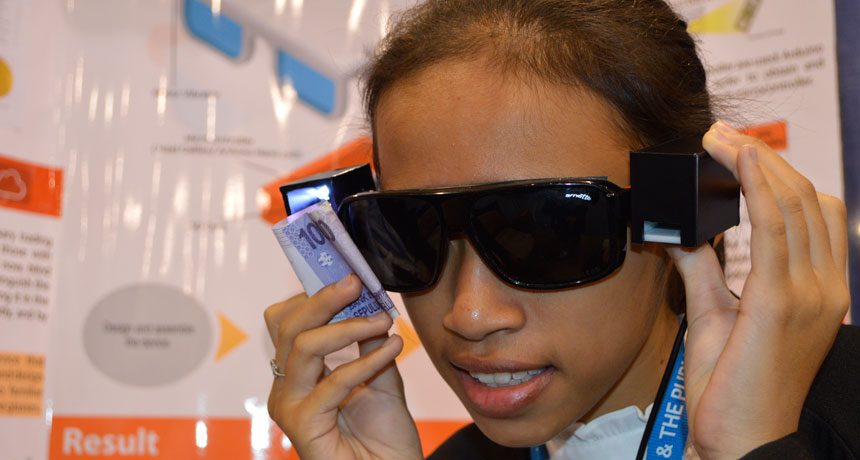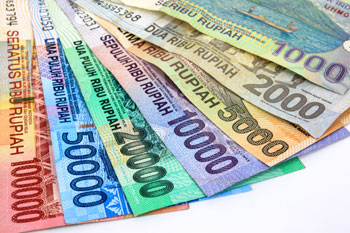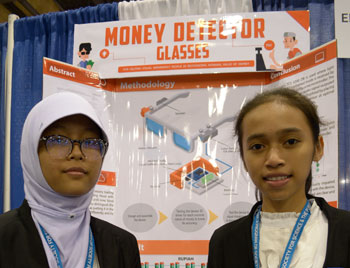New device identifies money by its color
Color-reading gadget could become a boon to blind people in a store’s checkout line

Quinita Noronha demonstrates her team’s new money reader. When a folded bill is held up to a prototype reader (small box attached to glasses), a sensor detects its overall color so that a computer can identify its value.
M. Chertock/ SSP
By Sid Perkins
PHOENIX, Ariz. — People who are blind have difficulty with many everyday tasks. Among them is figuring out the value of banknotes (paper money), especially when they are the same size. While shopping, many have to trust cashiers or other people to truthfully tell them the value of a bill in their hand. But now, two teens have invented a device to check a bill’s color and report its value.
The teens showcased their new currency reader here, this week, at the Intel International Science and Engineering Fair. Created by Society for Science & the Public and sponsored by Intel, the 2016 competition brought together more than 1,600 students from over 70 countries. (SSP also publishes Science News for Students.)
It’s usually easy to tell one coin from another. They tend to differ by size or weight. Other clues may include a coin’s thickness or the texture of its edge. But telling paper (or plastic) bills apart can be far harder. In the United States, for instance, one greenback will feel like every other.

Now, two teens have developed a device that can help consumers “read” the value of color-coded currencies. Quinita Noronha and Sepvina Mutikasari, both 16, are 12th graders at SMA Negeri 3 Yogyakarta School in Indonesia. Their device doesn’t use complicated software to identify a bill based on any pictures, numbers or patterns that are printed on it. Instead, a simple computer program analyzes the bill’s overall color.

After the computer identifies the folded bill’s value, it sends a signal to a small buzzer. This generates both a pattern of sound and vibration that is specific to the value of the bill being read, explains Sepvina. For example, two short beeps and vibrations might tell the person: “That’s a 2,000 rupiah bill.” (Today, 2,000 rupiahs is equal to about 15 U.S. cents.)
The team’s device can be programmed to recognize any type of folding money from any nation. But it probably would not work very well on U.S. currency, because all of its bills are so similar in color, the teens note. The device should work best for bills from nations that have distinctly different colors for each banknote, such as Indonesia, Canada and Great Britain.
Several things can affect the accuracy of the new money reader. If a bill is dirty or worn, it won’t have the same overall color as a brand new banknote. Also, trying to use the bill reader in a weirdly lit environment can alter the color’s score. Still, the teens’ experiments show that the bill reader is accurate about nine times out of 10.
For now, the team’s prototype looks a bit clunky. It includes two small plastic boxes filled with electronics, sensors and a buzzer. But one day all of that circuitry could be shrunk down onto a computer chip or two that easily could be incorporated into normal eyeglass frames and powered by a small battery. Then, someone wearing one of these devices while shopping wouldn’t look too unusual.
Power Words
(for more about Power Words, click here)
banknote A term for the foldable paper currency (some nations may now use plastic). Banknotes — sometimes called bills, as in a “20-dollar bill” — come in different denominations, and may vary by color or size. U.S. banknotes are often called “greenbacks” due to their predominantly green color.
currency The money (coins, banknotes, etc.) that a country uses as a medium of exchange.
denomination The face value of a banknote, coin or stamp.
light emitting diodes (LEDs) Electronic components that, as their name suggests, emit light when electricity flows through them. LEDs are very energy-efficient and often can be very bright. They have lately been replacing conventional lights in auto taillights and in some bulbs used for home lighting.
prototype A first or early model of some device, system or product that still needs to be perfected.
red-green-blue (RGB) One system for representing a color to be displayed on a computer or television screen. The overall color is described in terms of the value (intensity) of the individual components of red, blue and green. (These often are expressed as a percentage, from 0 to 100). By adding together the RGB values, it is possible to reproduce any color.
sensor A device that picks up information on physical or chemical conditions — such as temperature, barometric pressure, salinity, humidity, pH, light intensity or radiation — and stores or broadcasts that information. Scientists and engineers often rely on sensors to inform them of conditions that may change over time or that exist far from where a researcher can measure them directly.
Society for Science and the Public (or SSP) A nonprofit organization created in 1921 and based in Washington, D.C. Since its founding, SSP has been not only promoting public engagement in scientific research but also the public understanding of science. It created and continues to run three renowned science competitions: The Intel Science Talent Search (begun in 1942), the Intel International Science and Engineering Fair (initially launched in 1950) and Broadcom MASTERS (created in 2010). SSP also publishes award-winning journalism: in Science News (launched in 1922) and Science News for Students (created in 2003). Those magazines also host a series of blogs (including Eureka! Lab).
software The mathematical instructions that direct a computer’s hardware, including its processor, to perform certain operations.







